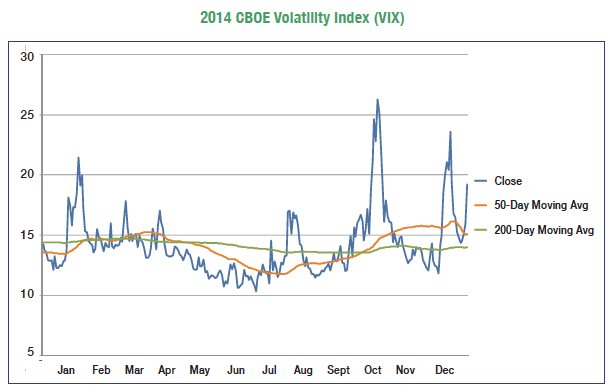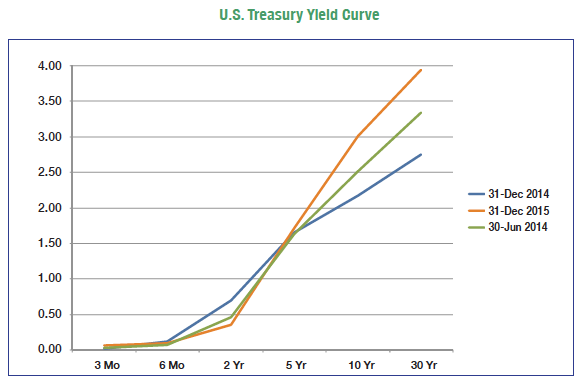2015 Outlook: Don’t Fight the Fed
 Entering 2015, market fundamentals remain similar to how they were a year ago. Globally, growth is slowing. Geopolitically, the landscape is charged. Economically, the US is improving, but slowly. You will recall that our stock market forecast for 2014 called for a below-average year considering these issues. Our expectation was for stocks to return a mid-single digit return, between five and seven percent. In fact, the S&P 500 returned 13.7%, a much stronger year than anticipated. Our forecast for stocks in 2015 is the same as it was a year ago: mid-single digit returns.
Entering 2015, market fundamentals remain similar to how they were a year ago. Globally, growth is slowing. Geopolitically, the landscape is charged. Economically, the US is improving, but slowly. You will recall that our stock market forecast for 2014 called for a below-average year considering these issues. Our expectation was for stocks to return a mid-single digit return, between five and seven percent. In fact, the S&P 500 returned 13.7%, a much stronger year than anticipated. Our forecast for stocks in 2015 is the same as it was a year ago: mid-single digit returns.
One of the primary reasons that the stock market performed better than we expected was interest rates remaining low. We thought we would see higher yields on bonds in 2014 as the Fed responded to better domestic economic conditions. However, the Fed hardly budged from their position on easy money and stocks rallied, particularly in the last few months of the year. In fact, at the close of business on October 15th, the S&P 500 was barely positive for the year and the Dow was negative by almost 3%. Both indexes rallied over 11% in just over two months—an incredible recovery. Most of this rally was due to the Fed sticking to its position on short-term interest rates.
Prior to the rally, the stock market was preparing itself for the eventual announcement from the Fed that they would begin raising short-term rates. The old adage “Don’t fight the Fed” is alive and well. If anyone thinks for a moment that stock prices are not inflated by the current Fed action, he or she only has to analyze this year’s trading. When the Fed finally does the right thing and begins increasing the Fed Funds rate, prices across multiple asset classes should fall somewhat. It remains our expectation that this Fed action will happen in 2015. Of course, the markets will not wait for the actual event but will anticipate it. Whatever the timing, the markets will be intensely focused on the messages that come out of the Fed, as has been the case since mid-2014.

With this increased focus has come a commensurate increase in volatility. The VIX, an index that tracks volatility, illustrates this increase. We see this trend in the chart below. We fully anticipate volatility will continue to increase as the market deals with all of the issues confronting it, the largest of which is the Fed. We continue to support investment in the ETN that tracks the VIX (VXX – iPath S&P 500 VIX Short-Term Futures ETN) for clients for whom it is appropriate. Typically, when volatility (as measured by the VIX) increases, stock prices decrease. Since this security tracks the VIX, it should offset some of the short-term pain of a market pullback.
The bond market has confounded many investors for a few years. The consensus view, and ours, that called for higher interest rates in 2014 did not come to pass. In fact, yields along the Treasury curve longer than five years were lower for most of the year. Interestingly, yields shorter than five years were higher than where they started the year (see Yield Curve graph). The flattening yield curve seems to indicate an expectation by the market that the Fed will raise rates soon, while the longer end of the curve indicates inflation is under control.
The global bond market is irrational at the moment. Government bonds from financially troubled countries like Spain and Italy are yielding less than US bonds. Clearly, government intervention in the markets caused these dislocations. Perhaps, the more appropriate way to say it is “Don’t fight the Central Banks.”
Interest rates in 2015 should increase across the curve. We expect the US economy to improve slowly. As it does, yields should move higher. The Fed should start to increase the Fed Funds rate sometime in the middle of the year, which should pressure rates to move higher as well. We would not be surprised to see the 10-year Treasury yielding 4% by the end of the year.
International stocks were weak throughout 2014 with most major markets down around 7%. Europe continued to struggle with its financial crisis. China’s growth is slowing, which impacts most countries, particularly emerging markets. Nevertheless, 2015 could prove to be a recovery year for international markets. As investors leave those markets, we become more interested. We have been underweight foreign stocks for most of the last two years. Although we are not ready to make a move yet, these markets appear attractive from a valuation perspective.

2015 should prove to be a challenging year for domestic stocks and bonds. Even though we are expecting a below-average year for stocks, they remain more appealing than bonds. Bonds should have negative returns next year. International stocks may be the most appealing asset class if their respective countries’ economies improve. The year should follow the lead provided by central banks around the world, with the Fed leading the charge. Just remember, “Don’t fight the Fed.”



